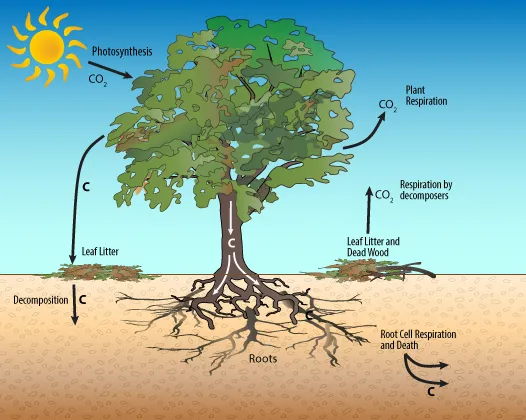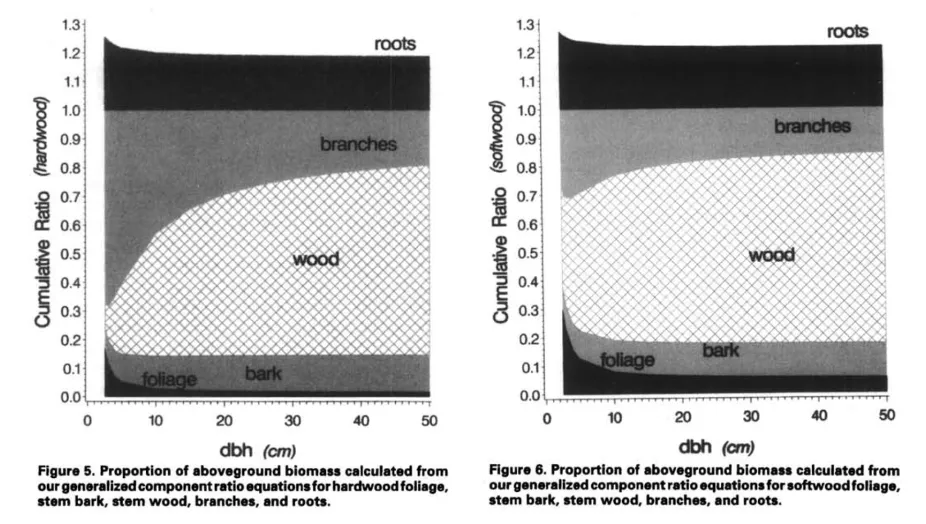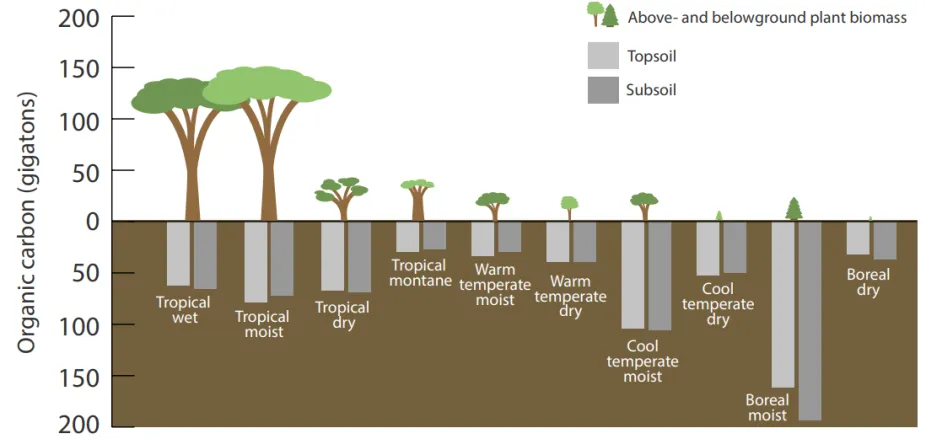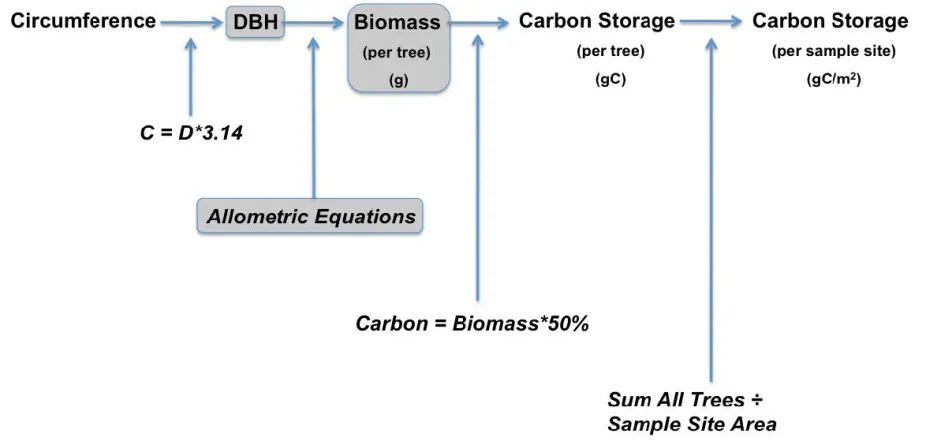What Can a Tree Do For You?
Introduction
Students consider how trees and forests are part of a solution to climate change by calculating the amount of carbon stored in a nearby tree, and evaluating climate solutions that involve trees.
Learning Goal
- Students learn about the importance of trees and forests for carbon sequestration as a climate solution.
Learning Objectives
- Students will use tree diameter and height measurements to estimate how much carbon is stored in a nearby tree.
- Students will analyze data about carbon sequestration in different forest types.
- Students will evaluate climate solutions that involve trees and forests.
Materials
- Tree image
- Video: Forests | Climate Emergency: Feedback Loops
- Carbon Cycle Diagram
- Pencils
- Whiteboard or chart paper and markers
- Fabric measuring tapes, or pieces of string and rulers
- Meter sticks, or pieces of string that are 1.35 m long
- GLOBE Observer app installed on tablets or smartphones
- Student access to laptops or tablets
- Optional: clipboards, tree species identification book
Preparation
- Students will benefit from having some background knowledge about photosynthesis, the carbon cycle, and climate warming due to fossil fuel emissions before beginning this activity.
- Print a copy of the Student Activity Sheets for each student and a copy of the Tree Data - Resource Sheet for each group.
- Identify trees on or near your school campus that students can use for measuring height and circumference. If possible, choose a few trees varying in size to provide variability in the data students will collect. Note: the carbon calculations are most accurate for trees that are at least 15m tall. If possible, find trees in a flat area instead of on a hill. Students will need to be able to walk in a straight line path from about 25 feet from the tree right up to the base of the tree to use the GLOBE Observer Tree Height measurement app.
- Create a (free) GLOBE Observer account so you and your students can use the Trees tool within the GLOBE Observer app to measure tree height. Each device will need to be logged in to this account to measure tree height (having multiple devices signed in to the same account is allowed), so consider that you will share your login credentials with your class when you are setting up your account. If you plan to use GLOBE Observer with your students multiple times, consider creating a GLOBE Team and creating an account for each student.
- Install the GLOBE Observer app on tablets or devices that students can use to measure tree height and practice using the Trees tool in the app prior to using it with your students.
Directions
Introduction (10 min)
- Project an image of a mature tree. Find an image online that portrays the grandeur of trees. Ask students if they have ever thought about all the different ways that trees are important, including as a solution to climate change.
- Give the class a moment to silently think of how trees affect the climate, and then ask students to share their ideas. It’s ok if they don’t know since they will learn about this in just a moment. (Trees remove CO2 from the atmosphere, store carbon, and release O2 into the atmosphere. When trees are removed, they also affect the climate - less O2, more CO2, less carbon storage.)
- Show from 0:45-3:43 of the video. Before showing the video clip, ask students to pay attention to how trees can help fight climate change (solutions) and also what things are threatening their ability to do so (problems). After watching the video clip, ask students to reflect back what they heard in the video - what problems and solutions were mentioned?
| Solutions: How can trees help to cool the climate? | Problems: What is threatening trees' ability to help cool the climate? |
|---|---|
|
|
- Remind students that in the video, we heard that forests capture close to 30% of fossil fuel emissions. Pose the question: I wonder how much carbon is stored in just one tree?
Part 1: How much carbon is in my tree? (45 min)
- Show the carbon cycle diagram, telling students to look at the parts of the diagram that involve trees. Ask if anyone can explain how trees store carbon. (Trees use carbon dioxide to make energy and grow, and most of the carbon from the carbon dioxide remains in the woody parts of the tree - trunk, branches, and roots. Carbon also ends up in the soils when leaves, needles, or fruits fall to the ground.)
- Share that all living things on Earth are made up of carbon. Living things also contain a lot of water. To estimate the amount of carbon stored in a tree, we need to figure out its biomass, which is the total mass of living matter in a given area or volume - minus the amount of water. And the size of the tree can help us figure out its mass.
- The amount of water and carbon varies between species and the environment they live in. Scientists have agreed to use the following values for trees: 45% water by mass and 50% carbon of the dry-mass (tree mass minus the water content).
- This might be a good time to review the definition of mass, if that would be helpful to your students. (Mass is the amount of matter in an object or given volume.)
- You may want to record these facts and definitions on the board to reference later.
- Tell them that we are going to take measurements of nearby trees so that we can estimate how much carbon they are storing.
- Pass out a copy of the Student Activity Sheets to each student.
- Break students into small groups and give each group the materials to measure their tree: a fabric measuring tape, meter stick, and a tablet (or allow one student per group to use their smartphone) with the GLOBE Observer app installed.
- Demonstrate and have students follow along as you log on to GLOBE Observer, select the Trees tool, and step through the tutorial (up to the Setup Information screen).
- Head outside to the trees that you have pre-selected. Assign each group to a tree and give them time to go through Part 1 of the student sheet.
- Point out that it is important that we measure the tree circumference from the same height (4 feet 5 inches or 135 cm), which is called the standard measuring point on the student activity sheet.
- Back in the classroom, pass out the Tree Data reference sheet and tell them to use Table 1 to figure out the amount of carbon (in pounds) their tree stores.
- Compare data from groups with different trees.
- Ask students to think about the impact of their tree on the climate. The discussion may include questions like:
- How much more carbon will my tree store as it grows over many years?
- How much carbon will a whole forest of trees store?
- How much carbon is being added to the atmosphere each year due to human activities?
- What will happen to the carbon stored in my tree once it dies, or if it burns?
- As a point of reference, you could share that in 2019 all of the flights worldwide produced 915 million tonnes of carbon dioxide. Converting from tonnes to pounds (1 tonne = 2,200 lbs), this is about 2,013 billion pounds of carbon dioxide. And this much CO2 contains about 548 billion pounds of carbon. If there is time, ask students to estimate how many trees we would need to store all the carbon from flights.
Part 2: Not All Forests Are the Same (25 min)
- Remind students of the conversation at the end of last class, thinking about the impact of our tree on the problem of global carbon emissions. Remind them that we want to think about how trees are one type of climate solution. Ask students to share anything that they are wondering about this point - what thoughts or ideas do they have?
- Share that not all trees and forests have the same carbon-storing ability, or even store carbon the same way. For example, old-growth trees store much more carbon than newly planted trees. Introduce the idea that, to understand how trees can be a climate solution, we must look closely at how trees store carbon and where these trees are.
- Direct students to Part 2 of the Activity Sheet. Orient students to the graph and information about forest types and how they store carbon on the student sheet. Ask students to explain what they think the graph is showing.
- Then orient them to Table 2 on the Tree Data - Resource Sheet, explaining what the data in each column means. Ask students to share something they notice about the carbon storage ability of different ecosystems.
- Give them time to complete Part 2 in pairs or small groups.
- As time allows, have students share answers to question #5 about where we could plant trees as a climate solution for the biggest impact.
- OPTIONAL: Show the rest of the Climate Emergency video about forests from the day before (about 10 minutes). The video goes into more detail about the three different forest types and how they store carbon, the challenges forests are facing, and how burning and deforestation cause trees to become sources of carbon instead of sinks for carbon.
Part 3: Trees as Climate Solutions (25 min)
- Tell students that there are more ways to think of trees as a climate solution than just planting trees. For example, we can protect existing forests and prioritize protecting areas where the trees are storing more carbon than others.
- Share that Project Drawdown is researching all the different types of climate solutions and how they could work. Direct students to the Project Drawdown/Solutions website and select Land Sinks to see several different solutions that involve trees (and other land sink solutions, such as agriculture). Orient students to the Project Drawdown website, looking at an example of one solution together to make ensure they understand the information within each solution - tell students to focus on the introduction, impacts, limitations, and conclusions sections.
- Have each small group choose one solution from Project Drawdown that involves trees to research. Be sure that the following solutions are covered, but allow student choice as well: Forest Protection, Temperate Forest Restoration, Tropical Forest Restoration, and Tree Plantations (on degraded land).
- Give them about 10 minutes to read about their solution and respond to the prompts in Part 3 of the student sheet. Encourage students to look up terms that they are unfamiliar with and discuss how they think the solution could be implemented. Remind students to write down questions they have about the solution as they work.
- Have a share out - this could be a gallery walk, passing their paper to a different group, or even informal presentations.
- Exit ticket: Have each student respond to this prompt as class wraps up: What would you say to someone who thinks that all we have to do to solve climate change is plant a bunch of trees? Explain.
Background Information
Trees and the Carbon Cycle

Carbon Cycle of a Single Tree
Valerie Martin, TERC
Through photosynthesis, trees use carbon dioxide from the atmosphere to make energy in the form of glucose, or sugar (C6H12O6). Glucose provides the building blocks for plants to make cellulose, which composes most of the woody tissue of trees. Trees accumulate cellulose as they grow, and the carbon that makes up the cellulose molecules is stored in the tree's wood, bark, branches, roots, and leaves.
Not all trees and forests store carbon in the same ways. Overall, most of the carbon is stored in the wood, branches, and roots, but the distribution of carbon storage depends on the type of tree (see figures below). Deciduous trees store less carbon in leaves (foliage) than Evergreens trees.

Figure 5 (left) refers to Deciduous trees; Figure 6 (right) refers to Evergreens. Jenkins, et al, 2003
Terrestrial plants and soils store carbon differently depending on the climate. The three largest carbon-storing terrestrial biomes are boreal forests, tropical forests, and temperate forests (see diagram below). Boreal forests have the greatest carbon-storing capacity, storing almost twice as much as tropical forests. Because of the cold temperatures of boreal forests, biomass breaks down very slowly and carbon dioxide is sequestered for thousands of years in permafrost soils and peatlands. Tropical forests store more carbon in the aboveground tree components (branches, trunks, and leaves), responsible for about 26% of terrestrial carbon sequestration, but carbon storage in the tropics is currently endangered due to deforestation.

The deforestation of tropical forests is responsible for 15-20% of global carbon emissions, and for this reason, protecting tropical forests must be a priority. Recent studies suggest that temperate forests actually store more carbon than tropical forests, and since old-growth temperate forests are targeted by logging industries, they are also at risk. Protecting old-growth temperate forests should also be prioritized as a climate change solution. Human land use changes affect the carbon stored in aboveground land sinks more than they affect the carbon stored in forest soils. (Temperate and Boreal Forests - still a considerable carbon sink.)
Trees also release some carbon dioxide directly into the atmosphere, mostly during the night when photosynthesis has paused and respiration continues, or when trees burn during wildfires or are burned for fuel. They also release carbon into the soils when leaves, needles, or fruits fall to the ground and decompose.
Forests are considered to be “carbon sinks” because they absorb more carbon than they release. They are responsible for an estimated 46% of terrestrial carbon sequestration (Science, 2015). According to the Arbor Day Foundation, a single mature tree can absorb about 48 pounds of carbon dioxide from the atmosphere in a year. For perspective, burning one gallon of gasoline releases about 20 pounds of carbon dioxide into the atmosphere. There are an estimated three trillion trees on the planet. However, humans are responsible for the loss of about 15 billion trees per year and have removed about 46% of the Earth’s trees since the beginning of human civilization (Science, 2015).
Biomass and Carbon
Biomass is the mass of all living things in a given area. Estimating the biomass of an area is helpful for a variety of reasons, such as wildlife management and forestry, but is particularly useful as a way to determine carbon storage in an area. All life is made of about 50% carbon atoms by dry mass, so multiplying the biomass by .50 provides a useful estimate of carbon storage. All living things also contain different amounts of water, so biomass is often measured as the dry mass after the mass of water content has been removed. Plant material can be dried to remove the water and then weighed to obtain the dry mass. However, it isn’t possible to weigh all the trees in a forest, or remove all the water from a forest, so equations that use average values for wood density and water content provide useful estimates. For this activity, we follow the method in the GLOBE, Biomass Units Learning Activity and assume trees are about 45% water by mass.
Calculations for Determining Carbon Storage In a Tree
The amount of carbon stored in a tree depends on several factors, including: tree species, tree age and size, forest density, environment, and growing conditions. There are a few different formulas used by the forestry industry and by researchers to make calculations of carbon or carbon dioxide storage. For the purposes of this activity, the formula used to estimate carbon storage per tree includes several equations (labeled as allometric equations in the diagram below) that estimate size and density based on tree diameter at breast height (DBH) to calculate biomass. The formula also assumes 45% of the wet tree biomass is water, and 50% carbon dry weight biomass. In this activity, students calculate the carbon storage per tree but this method can be extended to estimate carbon storage for all trees in a sampled area (see diagram below). Read more about the allometric equations used to calculate aboveground biomass.

The simplified equation above shows how researchers and foresters estimate carbon storage. The circumference of the tree is measured at breast height (135 cm) to calculate tree diameter (DBH). Then several allometric equations, or regression models, that estimate tree dry weight based on tree height and diameter are used to calculate an estimate of tree biomass. And using an agreed upon estimate that 50% of dry tree biomass is carbon, we can calculate carbon storage per tree. If the total number of trees or an estimate of the total number of trees in a sampled site area is known, the carbon storage in a given forest area can be estimated.
In this activity, students make two measurements to determine carbon storage for a tree:
- Tree circumference measurements can be used to calculate tree diameter. Diameter measurements are used to estimate the volume, biomass, and carbon storage of trees. Students will use a measuring tape to measure the circumference of a local tree at 135 cm (4 feet and 5 inches) above the ground. Note: measuring diameter at 135cm is referred to as diameter at breast height, or DBH.
- Tree height allows us to understand the gain or loss of biomass, which can inform calculations of the carbon that trees and forests remove from the atmosphere and release into the atmosphere. Students will use the GLOBE Observer app to measure tree height.
The estimates in Table 1 of the student sheet, which uses tree height and diameter to estimate carbon storage, are based on these formulas and assumptions:
MC (mass of carbon in the tree) = 0.5 x Mw (mass of the wood), where
Mw = 0.55 x V (volume of tree) x Dw (density of wood); V = 0.0567 + 0.5074 x DBH x H.
It assumes Dw = 0.6 g/cm3 and that water makes up 45% of the tree's mass.
Trees as a Climate Solution
As the climate warms due to human-caused greenhouse gas emissions, trees and their ability to remove carbon dioxide directly from the atmosphere are considered a possible solution. Many climate solutions focus on trees and other plants, such as reforestation, protecting existing forests, and bamboo production. Read more about climate solutions from Project Drawdown.
Deforestation by humans due to changes in land use and production of lumber and paper products decreases the global carbon storage capacity of trees and forests. Due to massive burning, parts of the Amazon Rainforest are now considered a source of carbon, meaning that they produce more carbon than they sequester.
Planting trees is not going to be enough to solve the climate crisis on its own, but stopping or slowing deforestation, protecting old-growth forests, and planting in creative ways are all important and crucial strategies that can have large impacts if done on a global scale.
Extensions
- Use the GLOBE Observer app to record and share data about trees on or around your school campus.
- Research how different communities are including trees in their climate resilience plans. Make a plan to integrate tree planting or tree conservation in your community.
- Learn about other ways that trees benefit communities and the planet.